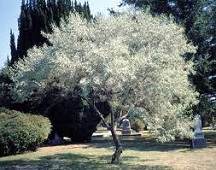Russian olive tree, also called Oleaster, thrives in most types of soil, forming an excellent windbreak, but is considered invasive as it spreads and crowds so easily that it eliminates the native species in a region. Read our guide for more facts an
The Russian olive tree has attractive silver-gray leaves and a thorny stem. The botanical name of the Russian olive tree, ‘Elaeagnus angustifolia’, is derived from the Greek words ‘Elaeo’ which means ‘olive’, ‘agnos’ that means ‘chaste’, and the Latin word ‘angustifolia’ that means ’ narrow-leaved’. It belongs to the southern part of Europe and the western part of Asia. It has only a remote relation to the olive tree, which is a native of Asia Minor, having spread from Syria, Iran and Palestine towards the Mediterranean basin, nearly six thousand years ago. Jerusalem’s Mount of Olives is known for its olive trees that are more than 200 years old.
Description of the Russian olive tree
The Russian olive is a small deciduous tree or rather a shrub, growing as high as 35 feet, and has a thorny stem with about half-inch alternate leaves. The narrow lance or egg-shaped leaves are silvery and have a scaly underside, while its flowers are yellowish. Its fruits grow in clusters during summer or spring, and range from green to yellow color. The tiny flowers are aromatic and sweet-smelling and provide food for useful insects. The tree begins to bear flowers and fruits at the age of three.
Features and uses of the Russian olive tree
The Russian olive came to America in the early 20th century and was planted widely to form wildlife habitat, for bird feed, as shelter belts and windbreaks and to control erosion. It has also been planted for mine reclamation. Its fruits are nutritious to cattle, deer, birds and rodents, and over 50 species of birds have been found to eat its fruit. Its dense branches provide a proper windbreak in windy regions such as Dakota and Montana, which are characterized by relentless winds and frequent droughts. It is not used to get olive oil or olives.
The Russian olive was introduced in the American continent in several mid-west states, many parts of western US and a few Canadian provinces. A study from Western Ontario Department of Geography details the spread of these trees and mentions that within 50 years of their introduction, the trees at the Milk River floodplain of Montana had spread downstream up to the Fresno reservoir and upstream to Alberta, and currently outnumber the native cottonwood trees. The seeds are viable for almost three years and are dispersed by birds, ice rafts and river water.
Downside of Russian olive trees
Russian olive trees spread swiftly along creeks, streams and river banks and choke out the native vegetation on riparian stretches, blocking access to water, and might even block irrigation ditches. Though they were renowned for their unique ability to flourish where other trees were unlikely to grow, now they are considered a harmful weed, owing to their invasive nature. They close open areas and displace native species and native habitats.
Because of these downsides, they are subject to systematic eradication via chemical and biological methods, and are controlled by mowing, burning, cutting, girdling, spraying and bulldozing. Though they can be planted to form a hedge, or can be planted for a landscape feature, they must be away from foundations and utility lines, owing to their invasive nature and sturdy root structure.





